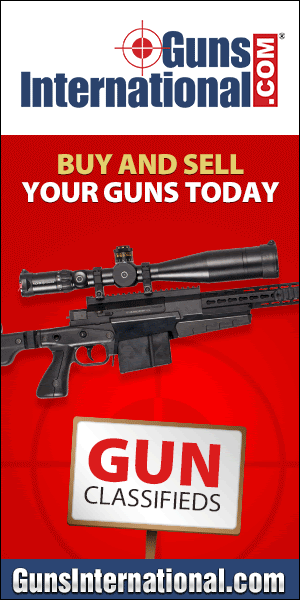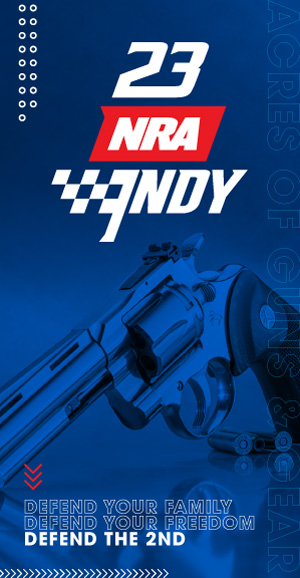The reasons for collecting antique firearms are endless, but certain ones are basic. Although the investment angle must play a role, it should be but part and parcel of stronger motivations which tie the collecting activities to some personal preference that has captured the imagination and curiosity of the prospective collector.
Getting Started in Gun Collecting
By Norm Flayderman
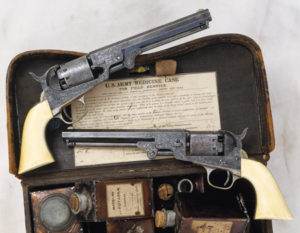
Appetites for gun collecting are often whetted by mechanical ingenuity, artistic features or historic associations. The possibilities and potential in collecting antique American arms are virtually unlimited; but these must be matched to both one’s pocketbook and the amount of time one can devote to what can become a possessive mistress. Probably the best approach to beginning a collection is to assemble a basic arms library and read those books thoroughly.
But, alas, years of stressing this point and offering the same advice many times over has found it to be the least often accepted counsel. Whether time is too precious or gun money tends to burn a large hole in one’s pocket, it seems the neophyte collector just cannot visualize that book hanging on two hooks on the wall!
This note of sarcasm is well intended, if the collector- to-be can persevere and acquire a few recommended basic primers, he will find his money very well spent indeed. Larger city libraries are bound to have a good shelf of gun books as do many of the larger book stores; a few dealers specialize in arms books and issue catalogs, or, a visit to a gun show will usually find dealers with a wide variety of titles on hand. '
The Bibliography, Chapter IV, should be found helpful as a guide to basic works. Thoroughly digesting such primers will provide a good cursory knowledge of what gun collecting is all about. Recommended as a basic starter is the recently published “331 Essential Tips and Tricks for the Gun Collector” by S.C. Mowbray (2006). Chapter IV. Armed with the basics, the next order of progression should be some astute travel—to a museum featuring a well-rounded or specialized collection (quite a few of these will be found throughout the country), to a gun collector’s home, to a dealer specializing in antique arms, or to a nearby gun show; (none of these need be in any special order).
New horizons will quickly be opened, especially at that visit to the first show where anywhere from a hundred to a thousand (or more!) tables may be seen displaying and offering for sale thousands of antique guns; a fascinating and unforgettable experience. Probably on display will be more guns than can be seen in most individual museums, plus a variety of accessories, parts and literature.
The shows also offer an excellent forum for meeting with a very wide crosssection of collectors and dealers. On the assumption the aspiring collector was able to attend that first gun show and not purchase anything (but some books), the next logical step should be to subscribe to a few of the regularly issued periodicals devoted to or featuring articles on collectors’ arms.
The importance of belonging to the National Rifle Association cannot be over-emphasized. Their highly respected and widely circulated publication The American Rifleman contains a great many informative articles for the gun collector, and the Association offers services to collectors who are members. Other periodicals devoted entirely to antique arms are of great value to the collector and should be subscribed to (see details in Bibliography). A host of other magazines covering modern weapons is readily available, and most of these carry some articles on antique and collectors’ firearms. The importance of all these periodicals to the neophyte is not only their wealth of informative articles, but the profusion of advertisements of dealers and collectors nationwide who are offering their services or their lists or their items for sale.
One of the best mediums of exchanges in the antique arms business is mail order. Advertisements and listings for all the regularly scheduled gun shows throughout the country will also be found in these publications. Before money is laid down for that first gun, it would be wise to have selected a general area in which to confine one’s collecting activities. Likely a choice was made by reading and by studying museum and private collections; at least some general guidelines should have been established, and the search for specimens can be confined to within a given category.
A key asset for the neophyte is a mentor whose opinion is valued (and who is not trying to sell one of his own guns!); an outside impartial opinion as to the wisdom of the first choice will do much to start the collector on the right foot when making that first selection at a gun show or at a dealer’s shop; it is also a great aid in building self-confidence. If on his own, then good common sense and judgment of human nature should take precedence when assessing circumstances surrounding the purchase of that first piece. Checking the reputation of a dealer or collector source is a worthy step, and remember that a guarantee, either verbal or written, is only as good as the party giving it.
On Guarantees
The matter of GUARANTEES is worth dwelling on for a moment. Regardless of what one might be told about a gun, and even if said data is committed to writing, there are so many vagaries involved that unless the party making the guarantee is reputable, it will be found worthless.
Proving an item is not what it is stated to be in a court of law is a highly involved process and a costly one as well. Courts and (most) lawyers know nothing about antique guns, so it is a matter of hiring witnesses (an expensive matter) and trying to educate judge and possibly jury as well!
Unless a gun is worth many thousands of dollars, there is little likelihood that the aggrieved owner will ever get satisfaction if the seller does not choose to honor a complaint. In only the most flagrant violations does a collector have a chance to get together a consensus from the seller’s peers and coerce him into making a disgruntled refund.
This discussion is not intended to lessen the importance of acquiring a detailed bill of sale, which in some cases may deter the seller from passing off a spurious piece.
A general observation in some five decades of dealing has shown that those highly detailed, multi-part bills are rarely asked for or offered, nor are they necessarily what they appear to be if the seller had larceny in his heart from the beginning! The entire subject has very broad legal and ethical implications not within the realm of discussion for this book, other than to bring them to the readers’ attention and strongly stress the extreme importance of knowing the party from whom the purchase was made. It is very much a matter of a man’s word being his bond.
A source of satisfaction for the majority of those active in gun collecting is that such a statement stands not merely as a hackneyed cliche, but a standard of one’s ethical code. Undoubtedly the best rule-of-thumb on purchasing antique guns, and one that is heard repeatedly, is to limit one’s buying as much as possible to quality and condition. Far better it is to have one good piece than a dozen “dogs.” This is one of the most difficult points to get across to new collectors, especially when they are itching to buy that first piece!
From studying human nature and collecting habits, it may be broadly stated that the new collector most often commits all the sins that he has been pointedly warned to avoid and that he ultimately comes to the realization that those were not such bad warnings after all.
Those seeming bargains just are not bargains and are so damned hard to pass by! The mere fact that a gun bears a price tag and is being sold by a dealer or collector in his shop or at a show is not necessarily a measure of actual or accurate worth. That tag does not always indicate the actual price a seller is willing to accept. In some instances it may even be purposefully inflated, outlandishly so; a rather crafty device to tempt the prospective buyer to make an offer, after which the trap closes quickly on the unwary!
The buyer must be prepared to analyze not only the weapon, but the person selling it, including their knowledge in that particular area, their method of doing business, their standing and reputation as a collector or dealer. On auction buying: The final rule-of-thumb on bargains is worth remembering when it comes to attending an auction.
Under no circumstances ever bid on any gun (or any other item for that matter) unless it has been very closely examined at the exhibition preceding the auction by yourself (preferably) or someone representing the collector and whose opinion is valued.
This is a time-honored, unwritten rule equally applicable to neophyte as well as expert. The novice, with no idea of gun values, has no business bidding at an auction and is gently cautioned to possess his soul with patience and wait until he has some collecting experience under his belt before entering bidding competition. Common sense dictates that when one stands toe to toe and slugs it out price-wise—and that is what auctions are all about—he should at the very least know what he is doing.
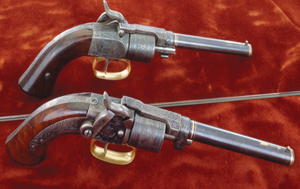
RECENT HISTORY AND PROGRESS OF ARMS COLLECTING
It is no exaggeration to say that the growth of the hobby of collecting antique firearms in the years following World War II has been phenomenal. Neither is it an exaggeration to claim for this field the right to be known as one of the fastest growing collecting pursuits since WWII. That era must decidedly be used as the turning point for all types of arms collecting, for it is only since then that these hobbies — especially in the field of American arms — have really taken off and risen to spectacular heights.
Those decades since the war feature technological advances along with a tremendous rise in the general affluence of the American public. Plotting the mushrooming of technology and affluence on a graph alongside the increasing importance of antique weapons collecting and their concurrent immense increase in demand and value would undoubtedly show extremely close correlation.
Earlier slowdowns in the pace of collecting have noticeably reversed themselves as this ninth edition goes to press. It continues to be brisk ... and in some areas, heated. Although the field is not broad enough nor considered sufficiently important by economists to have had any trend-studies made in the postwar decades, it can be said from first-hand knowledge that interest, demand and values in antique American arms have continued upward on a steady rise over the entire period. (Certain small segments of specialties within the field of American arms collecting have shown sudden spurts upwards in price, leveled off, and then even fallen slightly backward for a short period; those special areas, however, were extremely limited and in general had no influence on the overall antique American gun market.)
This steady upward rise included every recessionary era in business and economic cycles. The economic setback of the early 1980s continued that rise to a lesser degree, evidencing a general leveling of prices, while the broad recession of the early 1990s had no adverse affect on antique American arms values which continued their upward trend. Such was definitely not the case in other areas of collecting; such fields as coins, stamps, art and silver are especially notable. This factor has gone unnoticed by antiques commentators and editorialists. The phenomenon is quite intriguing. The author lacks experience as an economist to interpret either the why or wherefore, but it is certainly worth noting and musing over.
Prior to World War II antique guns, especially American ones, were very much on the low end of the collecting world scale. A few of the early Colts, some of the scarcer American martial flintlock handguns, and fine Kentucky rifles were about the only arms which fetched anywhere near noteworthy values. Those values, though, in comparison to other collecting fields, were still on the bottom rung of the ladder; only rarely rising above a three figure status. Fine European arms and armor of the 18th century and earlier were then very much in demand, but the collecting fraternity for those types was also small in size. Collecting of American arms was very much a narrowly confined field that is easily evident by the limited number of short-lived publications devoted to the hobby, as well as few published research studies or books.
Antique arms was hardly a field of any prominence when compared to such giants as the collecting of art, rare books, coins or stamps and other similar time-honored and popular hobbies and areas of investment. Since the War, the picture has changed drastically, but it is probably still very much a case of “not seeing the forest for all the trees.” In living during the era and actually seeing the changes take place, it remains difficult to arrive at an overall perspective and visualize what the potential may actually be.
Although certainly small by comparison to other collecting fields, the hard fact that not a few antique American arms have achieved price levels into the high six figure mark may very well be considered as a milestone and an indicator of what the future holds for what is still a very young collecting specialty. Proffered advice: condition will play an ever-increasing role in that future potential.
The foregoing remarks about price rises and new plateaus are not intended to indicate a feeling by the author that a stampede is about to take place (nor his hopes that it should!) in collecting American guns.
Active, and thus close to this field in the postwar years, the author is hardly a disinterested reporter. He therefore very much wishes to emphasize his observations about the monetary aspects of this collecting hobby; for after all, value is very much what this book is all about. Immediately following World War II, the collecting of antique arms gained ever-increasing popularity throughout the United States.
Attributing this growth to any single specific reason would be in error, but a broad generality considered credible would relate the rising American economy and public affluence combined with the prominence given gun collecting by many writers. These two factors in combination allowed and inspired a relatively undiscovered or unexploited field to blossom.
The same has happened in several other collecting pursuits and still takes place occasionally today. One wonders if anything remains “undiscovered.” With the mushrooming postwar awareness and interest in antique arms and the dramatic influx of new collectors, there simultaneously appeared a number of guides, handbooks and specialized studies. No doubt each book gave further impetus to the hobby.
With the rapid spread of knowledge the collector was afforded the opportunity to pursue many avenues of collecting formerly denied him due to a lack of published information. Many of the new books spawned hosts of specialist collectors and students, quite frequently leading to further research studies published in book or periodical form. The effect, although not then obvious, is quite evident in retrospect. The era of the 1950s ushered in a truly dramatic expansion in the hobby of gun collecting.
During those years a few important periodicals devoted almost entirely to antique weapons entered the field, some surviving to the present day. Several other journals have since become available on the subject, and the array of publications now in print is quite impressive.
The 1950s also saw the formation of new, as well as the expansion of existing, arms collecting clubs (many of them growing to giant size) throughout virtually every state in the Union.
Although antique arms shows were well-known even before World War II, they were usually small private affairs far from achieving prominence in the press or in the arms world. In the 1950s various state clubs began attracting guests and exhibitors on a nationwide basis while at the same time expanding their exhibition facilities from small rooms to grand exhibition halls.
In the early 50s it was quite possible to make a few important arms shows in a year; beginning in the 1960s and continuing to the present one could attend two or even three significant (sometimes enormous) shows almost every week of the year somewhere in the country! Prices for antique arms began their sharp and steady upward trend in the 50s. From that point they never backslid. It is true that all values did not rise proportionately nor at the same time, but plotting on a graph would definitely show a continued and progressive rise on a rather steep incline (with but one narrow plateau) through the late 1990s reaching another slowdown after the turn of the century.
A comparison of all preceding editions of this Guide, first available in 1977, confirms that trend. If the number of collectors were to be plotted on that same graph, the result would probably be an identically proportionate rise. The great influx of new collectors and the increasing affluence of Americans, combined with a general inflationary trend in money and the decreasing supply of available antique arms, were chief factors in creating the steady overall price rise through the 1950s and 1960s. As earlier mentioned, the recessionary cycles in the economy rarely played a noticeable role in lessening either demand for guns or downward trends in their prices.
Thus prices in most cases, if not continuing their rise, remained consistent or steady, then continued their upward trend the moment the economy resumed an even keel. In several instances highly specialized areas of arms collecting showed price rises out of proportion with the rest of the field. This was usually observed only in cases where a few collectors were attracted to a specialty and competed simultaneously for the very limited available specimens.
A noteworthy example was Confederate handguns; always a rare commodity commanding prices commensurate with their importance. In the mid-1960s a number of new collectors caused a sudden increased demand, and prices quickly rose almost unaccountably 50 to 100 percent.
The result was what might be termed somewhat of an hysteria in the market, particularly on the part of the neophyte collector. After a short period it was found that quite a few Confederate handguns were available with no takers, and a number of speculators trying to cash in on the demand found themselves holding the bag. The very fast and disproportionate price-rise had simply discouraged some of the new collectors who then gave up and went into other specialties; those who had speculated were loathe to take losses and thus for the next few years the Confederate handgun market merely stagnated. Others were discouraged from entering the field due to the number of unsold and over-priced guns on the market.
The passage of time and the general inflationary trend in the following years allowed the market to catch up with the prices of the Confederate handguns, and they once again took their rightful place of importance in the collecting field. Confederate handguns have not only continued to enjoy a healthy demand and solid sales, but now number among the arms showing the largest price increases.
The Confederate handgun is but the most noteworthy example of disproportionate price increases; similar episodes have occurred in other highly specialized arms areas. Certain models and types of Winchesters have been caught up in this hysteria of sudden price rises only to find themselves being topped out. The passage of time, though, has found the market catching up with the prices. It does take some astuteness and common sense to recognize what is happening when very sudden and steep increases occur quite disproportionate to developments in the rest of the market.
Steady growth both in numbers of collectors and values of specimens, coupled with a vast amount of research studies and publications during the 1960s and continuing to the present contributed to the upward overall trend in the antique firearms field. It is interesting to note that the books currently available on antique guns and related subjects number in the many hundreds; yet there is still much room for improvement of many texts, and for new studies in relatively unexplored fields. A much larger number of titles have gone out of print and are difficult to locate.
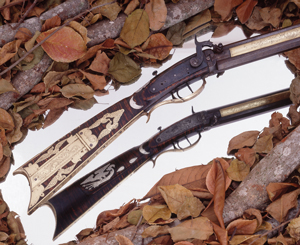
In the early 1970s the greatest, often record-setting price increases were noted. Momentum remained high through the entire 70s and right on into the early 80s. True, there was a leveling off and a readjustment in the deep recession in the early 80s but prices (except in a few isolated instances) never slid backwards at any time and demand never slackened; overpriced mediocre merchandise merely stagnated much as it always had. Both demand and prices had increased almost on the same scale as the runaway inflationary trend common throughout most of the world in the late 70s.
When inflation eased so too did the general price rise. The demand factor continued to reign supreme. Reviewing the “Introductions” of the preceding eight editions of this Guide offers a credible means to get a handle on what has taken place in this hobby in the past 30 years; a practical and reasonably accurate barometer. The general trend certainly affects ever-increasing values and also recognizes the added emphasis focused upon detail and manufacturing minutiae which continue to dominate many areas of specialty collecting.
Those same preceding years have seen greater significance, justly deserved, accorded to antique arms directly associated with specific eras and events in American history and the individuals that may have personally owned and carried them.
An interesting and influencing factor in changing the American antique arms market had been the entrance into the picture of the European buyer.
Until the late 1960s, the European antique arms market, especially as it existed for the sale of American arms, played no role of any consequence. In fact, up to the 1960s Americans had been able to purchase large quantities of antique arms in Europe (both American made pieces as well as European arms) for import and sale throughout the United States. In the late 1960s this trend was completely reversed.
Rising European affluence and a great influx of new collectors there caused rather meteoric rises in prices for arms in Europe, making it practically impossible for an American to purchase over there and import. European buyers (dealers and collectors) came to American shores to gather up great quantities of their own arms as well as American manufactured pieces to export for sale in their own countries. This situation was quite volatile and very much subject to the economy of the several countries involved as well as their currency restrictions (often subject to unpredictable fluctuations).
The European factor caused considerable change in the American market beginning in the early 1970s and was especially noticeable in affecting prices of American made guns of the Civil War and Indian War eras, mainly pieces in poor and mediocre condition. Quite a few Europeans have a great fascination with those periods of American history, and a heavy demand was created for weapons of those eras, partly influenced by a proliferation of television and movie Westerns. However, the European collector is generally not as discriminating a buyer condition-wise as is his American counterpart.
Hence, the demand was much greater for lower quality pieces, and prices for those arms shot up disproportionately. Demand and sale of American arms oscillates in direct ratio to the fluctuations of the economies (and money restrictions imposed) of individual European countries. In the early 1980s the European buyer, once here in prodigious numbers, had, like the passenger pigeon and the buffalo ... or even the dodo bird ... become an almost extinct species! Although he no longer directly affected the American market, he left behind a very wide following of lovers forsaken who, like the mariner’s wife, look forlornly to sea waiting for the ship to return!
Those same “lovers scorned” continued their lonely vigil with many sitting on piles of mediocrity they had accumulated for the foreign market; one which had merely been a temporary aberration on the collecting scene! The hysteria those dealers created in their frenzy to accumulate hoards of ordinary merchandise for Europe, left a trail of carnage behind them in the many unknowing collectors and small-time dealers who thought their mediocre guns were suddenly turning into gold all over America ... never realizing that it was only the temporary, short-lived European market that kindled, and ultimately doused the demand! The late 1980s and early 1990s saw a slow return of European and a few Scandinavian buyers to the American market searching for antique American arms as well as those of their respective countries.
By the mid 90s even that sporadic trend slackened. Their impact has been much more modest than it was with the earlier wave. Restrictive gun laws in a few countries have caused some to limit the scope of their purchases here.
While generally adding to the collectors’ market, they have not generated the volatility attendant to their earlier entry. Another interesting observation and reality of the antique arms business in America, and one for which no explanation is offered, is the changing pattern of the professional full-time antique arms dealer. In the 1940s and 1950s there were quite a few full-time dealers issuing catalogs on a regularly scheduled basis.
The number of such dealers today has dwindled to the point that less than a handful regularly issue sales catalogs. Very possibly this number may dwindle to nil, since there are but the slightest signs of dealers coming into the field who intend to regularly catalog their merchandise. Likewise, there is an apparent decreasing number of full-time dealers who have retail establishments open to the public at regular hours and to which the collector may freely visit.
The trend, with increasing frequency these past years, has shown a great influx of new and full-time dealers in the field, but their manner of conducting business is completely at contrast to the time-honored approach standard in almost every other collecting field. As a matter of fact, the modus operandi is peculiar to this antique arms business and offers an interesting insight into it.
The general antique arms dealer of today—and most likely those of the future—normally conducts business along four parallel lines: he travels to the better known and larger gun shows throughout the country; he advertises some of his best pieces in one or two of the better known and widely circulated antique arms publications; he has a small gun room or showroom associated with his home and will allow visits by appointment only; and, with ever-increasing frequency maintains a Web site on the Internet.
This article is an excerpt from Flayderman's Guide to Antique American Firearms. Click here to learn more.
Getting Started in Gun Collecting
By Norm Flayderman

Appetites for gun collecting are often whetted by mechanical ingenuity, artistic features or historic associations. The possibilities and potential in collecting antique American arms are virtually unlimited; but these must be matched to both one’s pocketbook and the amount of time one can devote to what can become a possessive mistress. Probably the best approach to beginning a collection is to assemble a basic arms library and read those books thoroughly.
But, alas, years of stressing this point and offering the same advice many times over has found it to be the least often accepted counsel. Whether time is too precious or gun money tends to burn a large hole in one’s pocket, it seems the neophyte collector just cannot visualize that book hanging on two hooks on the wall!
This note of sarcasm is well intended, if the collector- to-be can persevere and acquire a few recommended basic primers, he will find his money very well spent indeed. Larger city libraries are bound to have a good shelf of gun books as do many of the larger book stores; a few dealers specialize in arms books and issue catalogs, or, a visit to a gun show will usually find dealers with a wide variety of titles on hand. '
The Bibliography, Chapter IV, should be found helpful as a guide to basic works. Thoroughly digesting such primers will provide a good cursory knowledge of what gun collecting is all about. Recommended as a basic starter is the recently published “331 Essential Tips and Tricks for the Gun Collector” by S.C. Mowbray (2006). Chapter IV. Armed with the basics, the next order of progression should be some astute travel—to a museum featuring a well-rounded or specialized collection (quite a few of these will be found throughout the country), to a gun collector’s home, to a dealer specializing in antique arms, or to a nearby gun show; (none of these need be in any special order).
New horizons will quickly be opened, especially at that visit to the first show where anywhere from a hundred to a thousand (or more!) tables may be seen displaying and offering for sale thousands of antique guns; a fascinating and unforgettable experience. Probably on display will be more guns than can be seen in most individual museums, plus a variety of accessories, parts and literature.
The shows also offer an excellent forum for meeting with a very wide crosssection of collectors and dealers. On the assumption the aspiring collector was able to attend that first gun show and not purchase anything (but some books), the next logical step should be to subscribe to a few of the regularly issued periodicals devoted to or featuring articles on collectors’ arms.
The importance of belonging to the National Rifle Association cannot be over-emphasized. Their highly respected and widely circulated publication The American Rifleman contains a great many informative articles for the gun collector, and the Association offers services to collectors who are members. Other periodicals devoted entirely to antique arms are of great value to the collector and should be subscribed to (see details in Bibliography). A host of other magazines covering modern weapons is readily available, and most of these carry some articles on antique and collectors’ firearms. The importance of all these periodicals to the neophyte is not only their wealth of informative articles, but the profusion of advertisements of dealers and collectors nationwide who are offering their services or their lists or their items for sale.
One of the best mediums of exchanges in the antique arms business is mail order. Advertisements and listings for all the regularly scheduled gun shows throughout the country will also be found in these publications. Before money is laid down for that first gun, it would be wise to have selected a general area in which to confine one’s collecting activities. Likely a choice was made by reading and by studying museum and private collections; at least some general guidelines should have been established, and the search for specimens can be confined to within a given category.
A key asset for the neophyte is a mentor whose opinion is valued (and who is not trying to sell one of his own guns!); an outside impartial opinion as to the wisdom of the first choice will do much to start the collector on the right foot when making that first selection at a gun show or at a dealer’s shop; it is also a great aid in building self-confidence. If on his own, then good common sense and judgment of human nature should take precedence when assessing circumstances surrounding the purchase of that first piece. Checking the reputation of a dealer or collector source is a worthy step, and remember that a guarantee, either verbal or written, is only as good as the party giving it.
On Guarantees
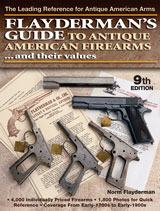 This article is an excerpt from Flayderman's Guide to Antique American Firearms. Click here to learn more. This article is an excerpt from Flayderman's Guide to Antique American Firearms. Click here to learn more. |
The matter of GUARANTEES is worth dwelling on for a moment. Regardless of what one might be told about a gun, and even if said data is committed to writing, there are so many vagaries involved that unless the party making the guarantee is reputable, it will be found worthless.
Proving an item is not what it is stated to be in a court of law is a highly involved process and a costly one as well. Courts and (most) lawyers know nothing about antique guns, so it is a matter of hiring witnesses (an expensive matter) and trying to educate judge and possibly jury as well!
Unless a gun is worth many thousands of dollars, there is little likelihood that the aggrieved owner will ever get satisfaction if the seller does not choose to honor a complaint. In only the most flagrant violations does a collector have a chance to get together a consensus from the seller’s peers and coerce him into making a disgruntled refund.
This discussion is not intended to lessen the importance of acquiring a detailed bill of sale, which in some cases may deter the seller from passing off a spurious piece.
A general observation in some five decades of dealing has shown that those highly detailed, multi-part bills are rarely asked for or offered, nor are they necessarily what they appear to be if the seller had larceny in his heart from the beginning! The entire subject has very broad legal and ethical implications not within the realm of discussion for this book, other than to bring them to the readers’ attention and strongly stress the extreme importance of knowing the party from whom the purchase was made. It is very much a matter of a man’s word being his bond.
A source of satisfaction for the majority of those active in gun collecting is that such a statement stands not merely as a hackneyed cliche, but a standard of one’s ethical code. Undoubtedly the best rule-of-thumb on purchasing antique guns, and one that is heard repeatedly, is to limit one’s buying as much as possible to quality and condition. Far better it is to have one good piece than a dozen “dogs.” This is one of the most difficult points to get across to new collectors, especially when they are itching to buy that first piece!
From studying human nature and collecting habits, it may be broadly stated that the new collector most often commits all the sins that he has been pointedly warned to avoid and that he ultimately comes to the realization that those were not such bad warnings after all.
Those seeming bargains just are not bargains and are so damned hard to pass by! The mere fact that a gun bears a price tag and is being sold by a dealer or collector in his shop or at a show is not necessarily a measure of actual or accurate worth. That tag does not always indicate the actual price a seller is willing to accept. In some instances it may even be purposefully inflated, outlandishly so; a rather crafty device to tempt the prospective buyer to make an offer, after which the trap closes quickly on the unwary!
The buyer must be prepared to analyze not only the weapon, but the person selling it, including their knowledge in that particular area, their method of doing business, their standing and reputation as a collector or dealer. On auction buying: The final rule-of-thumb on bargains is worth remembering when it comes to attending an auction.
Under no circumstances ever bid on any gun (or any other item for that matter) unless it has been very closely examined at the exhibition preceding the auction by yourself (preferably) or someone representing the collector and whose opinion is valued.
This is a time-honored, unwritten rule equally applicable to neophyte as well as expert. The novice, with no idea of gun values, has no business bidding at an auction and is gently cautioned to possess his soul with patience and wait until he has some collecting experience under his belt before entering bidding competition. Common sense dictates that when one stands toe to toe and slugs it out price-wise—and that is what auctions are all about—he should at the very least know what he is doing.

RECENT HISTORY AND PROGRESS OF ARMS COLLECTING
It is no exaggeration to say that the growth of the hobby of collecting antique firearms in the years following World War II has been phenomenal. Neither is it an exaggeration to claim for this field the right to be known as one of the fastest growing collecting pursuits since WWII. That era must decidedly be used as the turning point for all types of arms collecting, for it is only since then that these hobbies — especially in the field of American arms — have really taken off and risen to spectacular heights.
Those decades since the war feature technological advances along with a tremendous rise in the general affluence of the American public. Plotting the mushrooming of technology and affluence on a graph alongside the increasing importance of antique weapons collecting and their concurrent immense increase in demand and value would undoubtedly show extremely close correlation.
Earlier slowdowns in the pace of collecting have noticeably reversed themselves as this ninth edition goes to press. It continues to be brisk ... and in some areas, heated. Although the field is not broad enough nor considered sufficiently important by economists to have had any trend-studies made in the postwar decades, it can be said from first-hand knowledge that interest, demand and values in antique American arms have continued upward on a steady rise over the entire period. (Certain small segments of specialties within the field of American arms collecting have shown sudden spurts upwards in price, leveled off, and then even fallen slightly backward for a short period; those special areas, however, were extremely limited and in general had no influence on the overall antique American gun market.)
This steady upward rise included every recessionary era in business and economic cycles. The economic setback of the early 1980s continued that rise to a lesser degree, evidencing a general leveling of prices, while the broad recession of the early 1990s had no adverse affect on antique American arms values which continued their upward trend. Such was definitely not the case in other areas of collecting; such fields as coins, stamps, art and silver are especially notable. This factor has gone unnoticed by antiques commentators and editorialists. The phenomenon is quite intriguing. The author lacks experience as an economist to interpret either the why or wherefore, but it is certainly worth noting and musing over.
Prior to World War II antique guns, especially American ones, were very much on the low end of the collecting world scale. A few of the early Colts, some of the scarcer American martial flintlock handguns, and fine Kentucky rifles were about the only arms which fetched anywhere near noteworthy values. Those values, though, in comparison to other collecting fields, were still on the bottom rung of the ladder; only rarely rising above a three figure status. Fine European arms and armor of the 18th century and earlier were then very much in demand, but the collecting fraternity for those types was also small in size. Collecting of American arms was very much a narrowly confined field that is easily evident by the limited number of short-lived publications devoted to the hobby, as well as few published research studies or books.
Antique arms was hardly a field of any prominence when compared to such giants as the collecting of art, rare books, coins or stamps and other similar time-honored and popular hobbies and areas of investment. Since the War, the picture has changed drastically, but it is probably still very much a case of “not seeing the forest for all the trees.” In living during the era and actually seeing the changes take place, it remains difficult to arrive at an overall perspective and visualize what the potential may actually be.
Although certainly small by comparison to other collecting fields, the hard fact that not a few antique American arms have achieved price levels into the high six figure mark may very well be considered as a milestone and an indicator of what the future holds for what is still a very young collecting specialty. Proffered advice: condition will play an ever-increasing role in that future potential.
The foregoing remarks about price rises and new plateaus are not intended to indicate a feeling by the author that a stampede is about to take place (nor his hopes that it should!) in collecting American guns.
Active, and thus close to this field in the postwar years, the author is hardly a disinterested reporter. He therefore very much wishes to emphasize his observations about the monetary aspects of this collecting hobby; for after all, value is very much what this book is all about. Immediately following World War II, the collecting of antique arms gained ever-increasing popularity throughout the United States.
Attributing this growth to any single specific reason would be in error, but a broad generality considered credible would relate the rising American economy and public affluence combined with the prominence given gun collecting by many writers. These two factors in combination allowed and inspired a relatively undiscovered or unexploited field to blossom.
The same has happened in several other collecting pursuits and still takes place occasionally today. One wonders if anything remains “undiscovered.” With the mushrooming postwar awareness and interest in antique arms and the dramatic influx of new collectors, there simultaneously appeared a number of guides, handbooks and specialized studies. No doubt each book gave further impetus to the hobby.
With the rapid spread of knowledge the collector was afforded the opportunity to pursue many avenues of collecting formerly denied him due to a lack of published information. Many of the new books spawned hosts of specialist collectors and students, quite frequently leading to further research studies published in book or periodical form. The effect, although not then obvious, is quite evident in retrospect. The era of the 1950s ushered in a truly dramatic expansion in the hobby of gun collecting.
During those years a few important periodicals devoted almost entirely to antique weapons entered the field, some surviving to the present day. Several other journals have since become available on the subject, and the array of publications now in print is quite impressive.
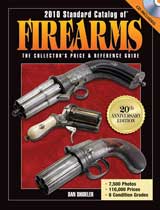 If you're serious about gun collecting, fill a space on your bookshelf with the definitive reference on firearms, the 2010 Standard Catalog of Firearms. Click Here If you're serious about gun collecting, fill a space on your bookshelf with the definitive reference on firearms, the 2010 Standard Catalog of Firearms. Click Here |
Although antique arms shows were well-known even before World War II, they were usually small private affairs far from achieving prominence in the press or in the arms world. In the 1950s various state clubs began attracting guests and exhibitors on a nationwide basis while at the same time expanding their exhibition facilities from small rooms to grand exhibition halls.
In the early 50s it was quite possible to make a few important arms shows in a year; beginning in the 1960s and continuing to the present one could attend two or even three significant (sometimes enormous) shows almost every week of the year somewhere in the country! Prices for antique arms began their sharp and steady upward trend in the 50s. From that point they never backslid. It is true that all values did not rise proportionately nor at the same time, but plotting on a graph would definitely show a continued and progressive rise on a rather steep incline (with but one narrow plateau) through the late 1990s reaching another slowdown after the turn of the century.
A comparison of all preceding editions of this Guide, first available in 1977, confirms that trend. If the number of collectors were to be plotted on that same graph, the result would probably be an identically proportionate rise. The great influx of new collectors and the increasing affluence of Americans, combined with a general inflationary trend in money and the decreasing supply of available antique arms, were chief factors in creating the steady overall price rise through the 1950s and 1960s. As earlier mentioned, the recessionary cycles in the economy rarely played a noticeable role in lessening either demand for guns or downward trends in their prices.
Thus prices in most cases, if not continuing their rise, remained consistent or steady, then continued their upward trend the moment the economy resumed an even keel. In several instances highly specialized areas of arms collecting showed price rises out of proportion with the rest of the field. This was usually observed only in cases where a few collectors were attracted to a specialty and competed simultaneously for the very limited available specimens.
A noteworthy example was Confederate handguns; always a rare commodity commanding prices commensurate with their importance. In the mid-1960s a number of new collectors caused a sudden increased demand, and prices quickly rose almost unaccountably 50 to 100 percent.
The result was what might be termed somewhat of an hysteria in the market, particularly on the part of the neophyte collector. After a short period it was found that quite a few Confederate handguns were available with no takers, and a number of speculators trying to cash in on the demand found themselves holding the bag. The very fast and disproportionate price-rise had simply discouraged some of the new collectors who then gave up and went into other specialties; those who had speculated were loathe to take losses and thus for the next few years the Confederate handgun market merely stagnated. Others were discouraged from entering the field due to the number of unsold and over-priced guns on the market.
The passage of time and the general inflationary trend in the following years allowed the market to catch up with the prices of the Confederate handguns, and they once again took their rightful place of importance in the collecting field. Confederate handguns have not only continued to enjoy a healthy demand and solid sales, but now number among the arms showing the largest price increases.
The Confederate handgun is but the most noteworthy example of disproportionate price increases; similar episodes have occurred in other highly specialized arms areas. Certain models and types of Winchesters have been caught up in this hysteria of sudden price rises only to find themselves being topped out. The passage of time, though, has found the market catching up with the prices. It does take some astuteness and common sense to recognize what is happening when very sudden and steep increases occur quite disproportionate to developments in the rest of the market.
Steady growth both in numbers of collectors and values of specimens, coupled with a vast amount of research studies and publications during the 1960s and continuing to the present contributed to the upward overall trend in the antique firearms field. It is interesting to note that the books currently available on antique guns and related subjects number in the many hundreds; yet there is still much room for improvement of many texts, and for new studies in relatively unexplored fields. A much larger number of titles have gone out of print and are difficult to locate.

In the early 1970s the greatest, often record-setting price increases were noted. Momentum remained high through the entire 70s and right on into the early 80s. True, there was a leveling off and a readjustment in the deep recession in the early 80s but prices (except in a few isolated instances) never slid backwards at any time and demand never slackened; overpriced mediocre merchandise merely stagnated much as it always had. Both demand and prices had increased almost on the same scale as the runaway inflationary trend common throughout most of the world in the late 70s.
When inflation eased so too did the general price rise. The demand factor continued to reign supreme. Reviewing the “Introductions” of the preceding eight editions of this Guide offers a credible means to get a handle on what has taken place in this hobby in the past 30 years; a practical and reasonably accurate barometer. The general trend certainly affects ever-increasing values and also recognizes the added emphasis focused upon detail and manufacturing minutiae which continue to dominate many areas of specialty collecting.
Those same preceding years have seen greater significance, justly deserved, accorded to antique arms directly associated with specific eras and events in American history and the individuals that may have personally owned and carried them.
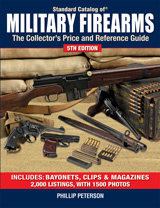 The Standard Catalog of Military Firearms is the ultimate reference for collectors of military arms. Click here to order your copy. The Standard Catalog of Military Firearms is the ultimate reference for collectors of military arms. Click here to order your copy. |
Until the late 1960s, the European antique arms market, especially as it existed for the sale of American arms, played no role of any consequence. In fact, up to the 1960s Americans had been able to purchase large quantities of antique arms in Europe (both American made pieces as well as European arms) for import and sale throughout the United States. In the late 1960s this trend was completely reversed.
Rising European affluence and a great influx of new collectors there caused rather meteoric rises in prices for arms in Europe, making it practically impossible for an American to purchase over there and import. European buyers (dealers and collectors) came to American shores to gather up great quantities of their own arms as well as American manufactured pieces to export for sale in their own countries. This situation was quite volatile and very much subject to the economy of the several countries involved as well as their currency restrictions (often subject to unpredictable fluctuations).
The European factor caused considerable change in the American market beginning in the early 1970s and was especially noticeable in affecting prices of American made guns of the Civil War and Indian War eras, mainly pieces in poor and mediocre condition. Quite a few Europeans have a great fascination with those periods of American history, and a heavy demand was created for weapons of those eras, partly influenced by a proliferation of television and movie Westerns. However, the European collector is generally not as discriminating a buyer condition-wise as is his American counterpart.
Hence, the demand was much greater for lower quality pieces, and prices for those arms shot up disproportionately. Demand and sale of American arms oscillates in direct ratio to the fluctuations of the economies (and money restrictions imposed) of individual European countries. In the early 1980s the European buyer, once here in prodigious numbers, had, like the passenger pigeon and the buffalo ... or even the dodo bird ... become an almost extinct species! Although he no longer directly affected the American market, he left behind a very wide following of lovers forsaken who, like the mariner’s wife, look forlornly to sea waiting for the ship to return!
Those same “lovers scorned” continued their lonely vigil with many sitting on piles of mediocrity they had accumulated for the foreign market; one which had merely been a temporary aberration on the collecting scene! The hysteria those dealers created in their frenzy to accumulate hoards of ordinary merchandise for Europe, left a trail of carnage behind them in the many unknowing collectors and small-time dealers who thought their mediocre guns were suddenly turning into gold all over America ... never realizing that it was only the temporary, short-lived European market that kindled, and ultimately doused the demand! The late 1980s and early 1990s saw a slow return of European and a few Scandinavian buyers to the American market searching for antique American arms as well as those of their respective countries.
By the mid 90s even that sporadic trend slackened. Their impact has been much more modest than it was with the earlier wave. Restrictive gun laws in a few countries have caused some to limit the scope of their purchases here.
While generally adding to the collectors’ market, they have not generated the volatility attendant to their earlier entry. Another interesting observation and reality of the antique arms business in America, and one for which no explanation is offered, is the changing pattern of the professional full-time antique arms dealer. In the 1940s and 1950s there were quite a few full-time dealers issuing catalogs on a regularly scheduled basis.
The number of such dealers today has dwindled to the point that less than a handful regularly issue sales catalogs. Very possibly this number may dwindle to nil, since there are but the slightest signs of dealers coming into the field who intend to regularly catalog their merchandise. Likewise, there is an apparent decreasing number of full-time dealers who have retail establishments open to the public at regular hours and to which the collector may freely visit.
The trend, with increasing frequency these past years, has shown a great influx of new and full-time dealers in the field, but their manner of conducting business is completely at contrast to the time-honored approach standard in almost every other collecting field. As a matter of fact, the modus operandi is peculiar to this antique arms business and offers an interesting insight into it.
The general antique arms dealer of today—and most likely those of the future—normally conducts business along four parallel lines: he travels to the better known and larger gun shows throughout the country; he advertises some of his best pieces in one or two of the better known and widely circulated antique arms publications; he has a small gun room or showroom associated with his home and will allow visits by appointment only; and, with ever-increasing frequency maintains a Web site on the Internet.
This article is an excerpt from Flayderman's Guide to Antique American Firearms. Click here to learn more.




